- Visibility 86 Views
- Downloads 12 Downloads
- DOI 10.18231/j.ijced.2021.051
-
CrossMark
- Citation
A rare case report of elastosis perforans serpiginosa in acquired cutis laxa
Introduction
Elastosis perforans serpiginosa is a rare perforating disorder characterized by transepidermal elimination of fragmented elastic fibres, clinically present as hyperkeratotic papules which arranged in a serpiginous manner.
EPS classified in to 1. Idiopathic 2. Reactive, (with other associated connective tissue disease) 3. Induced by Pencillamine.[1]
Cutis laxa is a rare disorder of connective tissue, characterized by loose, pendulous and inelastic skin. [2] They present as generalized or localized form which can occur secondary to trauma or following infection.
Case Report
27 years old female, presented with complaint of excessive and sagging folds of skin on front and lateral aspect of neck since 17 years complaint of black colored eruption on sagged skin on neck since 7 months. She didn’t have any chest deformities, No hyper extensibility of joints, no cardiac and ophthalmic involvement. Dermatological examination revealed hyperkeratotic papules ([Figure 1]) about 1-2 mm arranged in a serpiginous manner over anterior aspect of neck ([Figure 2]). Skin over the papules is loose, pendulous, inelastic skin extending from anterior aspect to lateral margins of neck ([Figure 3], [Figure 4]).
Patient is a not a hypertensive. All Other systems that are commonly Involved are evaluated. Ophthalmic- cornea / Fundus- normal Cardiac vascular system-no ECG and 2D ECHO changes. X-ray of chest Revealed no emphysematous change, gastrointestinal system- normal. No hyper extensibility of joints.



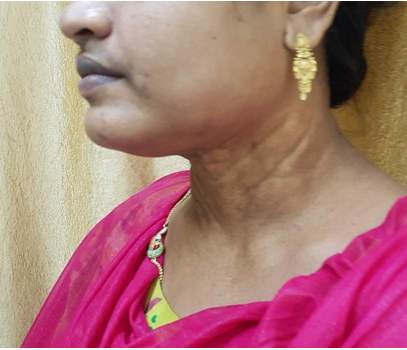
Histopathological examination of hyperkeratotic papule revealed (H&E) crater filled with fragmented elastic fibers. A narrow trans epidermal channel showing elimination of elastin fibers and dermis shows lymphocytic infiltration. And the biopsy specimen from loose, elastic, pendulous skin shows normal epidermis with diminished Elastic fibers. And dermis shows lymphohistocytic infiltrate and fragmentation of elastic fibres.[3]
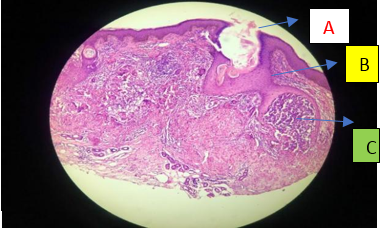
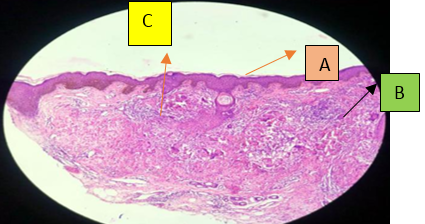
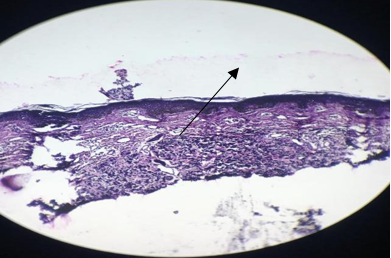
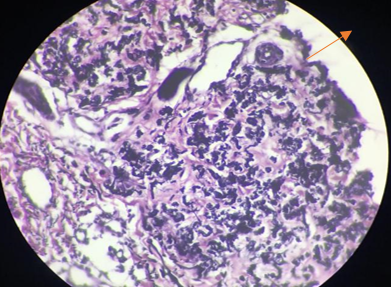
Elastosis Perforans Serpiginosa
Elastosis perforans serpiginosa (EPS) is a rare disorder classified as a primary perforating dermatosis characterised by transepidermal elimination of elastin fibres. [4] EPS first described by Lutz in 1953. [5] They clinically present as small asymptomatic hyperkeratotic papules that are arranged in serpiginous manner most commonly distributed over neck, face, arms and flexural areas. Pathogenesis for EPS remain unknown. Other possible factors that[6] trigger EPS are Down syndrome, Scabies, osteogenesis imperfecta Scleroderma and other connective disorders like Marfans syndrome, cutis laxa, and pseudoxanthoma elasticum[7] and in chronic renal failure. Other commonly encountered cases for EPS are patients on pencillamine therapy.[1] It can occur Denovo without any underlying cause. It has to be differentiated from other perforating disorders. EPS best diagnosed with a biopsy and histological examination. histopathology of hyperkeratotic papules revealed a crater that is filled with eosinophilic material that are extruding out are elastic fibres this confirmed with the special stain vongieson stain. vongieson stain the elastic fibers as black. The treatment modalities include topicals such as tretinion (o.1%, 0.05 %) steroids and imiquimiod, tazoretene, glycolic acid, salicylic acid and intralesional steroids, oral retinoids and curettage. Other treatment modalities include carbon-dioxide laser, ND: YAG laser and Pulsed dye laser of (585 nm, 6.0 -7.0 j/cm2).[8]
Cutis laxa is a rare connective disease characterised by loose Pendulous in elastic skin that may be inherited[9] cause or acquired. Acquired cutis laxa is rarer cause than congenital. They are of two types in acquired type generalised (adult onset mostly), Localised -Marshall’s syndrome (seen in younger people). Acquired form occur secondary to any infections, trauma, eczemas, urticarial. Diagnosis is usually by clinical suspicion and confirmed by skin biopsy and histopathological examination. Histopathology of lesion shows normal epidermis with diminished elastic fibres, infiltration and elastic fibres are fragmented in dermis. It has to be differentiated from other connective tissue disease by Vongiesonstain.[10] Treatment of cutis laxa is mainly conservative.
The association of EPS in a case of acquired cutis laxa is very rarely reported hence we are reporting this case.
Conflict of Interest
The authors declare that there are no conflicts of interest in this paper.
Source of Funding
None.
References
- S Young Na, M Choi, MJ Kim, JH Lee, S Cho. Penicillamine-induced Elastosis Perforans Serpiginosa and Cutis Laxa in a Patient with Wilson's Disease. Ann Dermatol 2010. [Google Scholar]
- O Le Saux, S Bunda, CM Vanwart, V Douet, L Got, L Martin. Serum factors from pseudoxanthoma elasticum patients alter elastic fiber formation in vitro. J Invest Dermatol 2006. [Google Scholar] [Crossref]
- K H Neldner. Pseudoxanthoma elasticum. Clin Dermatol 1988. [Google Scholar] [Crossref]
- F Ringpfeil, M G Lebwohl, A M Christiano, J Uitto. Pseudoxanthoma elasticum: Mutations in the MRP6 gene encoding a transmembrane ATP-binding cassette (ABC) transporter. Proc Natl Acad Sci USA 2000. [Google Scholar] [Crossref]
- S Hellriegel, HP Bertsch, S Emmert. Elastosis Perforans Serpiginosa A Case of a Penicillamine-Induced Degenerative Dermatosis. JAMA Dermatol 2014. [Google Scholar] [Crossref]
- K Venkatachalam, K Chennamsetty. Elastosis perforans serpiginosa in a case of pseudoxanthoma elasticum: A rare association. Indian Dermatol Online J 2016. [Google Scholar]
- N Chassaing, L Martin, P Calvas, M Le Bert, A Hovnanian. Pseudoxanthoma elasticum: A clinical, pathophysiological and genetic update including 11 novelABCC6 mutations. J Med Genet 2005. [Google Scholar] [Crossref]
- A A Bergen, A S Plomp, E J Schuurman, S Terry, M Breuning, H Dauwerse. Mutations in ABCC6 cause pseudoxanthoma elasticum. Nat Genet 2000. [Google Scholar] [Crossref]
- E G Pfendner, J Uitto, G F Gerard, S F Terry. Pseudoxanthoma elasticum: Genetic diagnostic markers. Expert Opin Mol Diagn 2008. [Google Scholar] [Crossref]
- Q Jiang, J Uitto. Pseudoxanthoma elasticum: A metabolic disease?. J Invest Dermatol 2006. [Google Scholar] [Crossref]
How to Cite This Article
Vancouver
Roja R, Pemmaraju R, Pasagadugula KV, Penugonda RNSS. A rare case report of elastosis perforans serpiginosa in acquired cutis laxa [Internet]. IP Indian J Clin Exp Dermatol. 2025 [cited 2025 Sep 04];7(3):270-273. Available from: https://doi.org/10.18231/j.ijced.2021.051
APA
Roja, R., Pemmaraju, R., Pasagadugula, K. V., Penugonda, R. N. S. S. (2025). A rare case report of elastosis perforans serpiginosa in acquired cutis laxa. IP Indian J Clin Exp Dermatol, 7(3), 270-273. https://doi.org/10.18231/j.ijced.2021.051
MLA
Roja, R, Pemmaraju, Ramanamurthy, Pasagadugula, Krishnarao V, Penugonda, Raajitha N S S. "A rare case report of elastosis perforans serpiginosa in acquired cutis laxa." IP Indian J Clin Exp Dermatol, vol. 7, no. 3, 2025, pp. 270-273. https://doi.org/10.18231/j.ijced.2021.051
Chicago
Roja, R., Pemmaraju, R., Pasagadugula, K. V., Penugonda, R. N. S. S.. "A rare case report of elastosis perforans serpiginosa in acquired cutis laxa." IP Indian J Clin Exp Dermatol 7, no. 3 (2025): 270-273. https://doi.org/10.18231/j.ijced.2021.051
